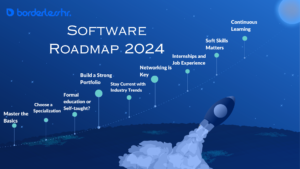Becoming a software engineer in 2024 requires a clear and practical roadmap. It’s crucial to stay updated with the latest trends and technologies. This article will provide you with a straightforward guide on how to embark on your journey to becoming a proficient software engineer in 2024.
In any endeavor, a clear roadmap serves as a guiding light, illuminating the path to success. It provides a structured framework, ensuring that you make informed decisions and progress steadily towards your goal. In software engineering, where complexity can often be overwhelming, a well-defined roadmap acts as a compass, directing you toward the most crucial milestones.
As we step into the year 2024, the field of software engineering is set for even greater advancements. Innovations in artificial intelligence, blockchain technology, and augmented reality are set to revolutionize industries across the globe. The demand for skilled software engineers is expected to soar, creating a wealth of opportunities for those with the right skills and knowledge. In this dynamic landscape, it’s imperative to not only master the fundamentals but also to adapt and grow alongside the rapidly evolving tech ecosystem.
Step 1: Master the Basics
A strong foundation is the bedrock of a successful career in software engineering. Before looking into complex programming languages and frameworks, it is important to establish a solid grounding in the fundamentals. This serves as the building block upon which more advanced skills and knowledge will be built. Begin your journey by immersing yourself in fundamental programming languages like Python, JavaScript, or Java.
These languages are widely used across various domains of software development and form the cornerstone of many applications. As you embark on this learning process, place a significant emphasis on writing code that is not only functional but also clean and efficient. Clear and concise code makes troubleshooting and debugging more manageable and enhances your work’s readability and maintainability, a crucial aspect in collaborative development environments. This emphasis on foundational skills will provide you with a solid footing as you progress further in your pursuit of becoming a proficient software engineer.
Step 2: Choose a Specialization
Software engineering is a diverse field encompassing various specializations, ranging from web development to mobile app development and data science, among others. To embark on your journey toward becoming a proficient software engineer in 2024, it’s crucial to narrow down your focus and choose a specialization that aligns with your career goals. Take the time to explore the different domains within software engineering to gain a comprehensive understanding of each.
Once you have a grasp of the options available, turn your attention inward. Identify your personal interests, strengths, and areas that genuinely captivate your attention. This introspective process will play a pivotal role in guiding you toward the specialization that resonates most with your aspirations and professional objectives. Remember, choosing the right specialization sets the foundation for a fulfilling and successful career in software engineering.
Step 3: Formal Education or Self-Taught?
When it comes to pursuing a career in software engineering, individuals have the option to choose between formal education and self-taught methods. Formal education in computer science or related fields undoubtedly provides a structured learning environment, often with access to experienced instructors and a comprehensive curriculum. This path offers a deep dive into theoretical concepts and hands-on labs, which can be invaluable in building a strong foundation. On the other hand, it’s worth noting that many successful software engineers have taken the self-taught route.
Online platforms like Coursera, Udemy, and freeCodeCamp have given access to a wealth of resources for self-paced learning. These platforms offer a wide range of courses covering various types of programming languages, frameworks, and specialized fields within software engineering. This flexibility allows learners to tailor their education to their specific interests and career goals. Striking a balance between formal education and self-paced learning can be a powerful approach, combining the benefits of structured instruction with the adaptability and depth of self-guided exploration. This way, aspiring software engineers can harness the best of both worlds to shape a robust skill set and excel in the dynamic field of software engineering.
Step 4: Build a Strong Portfolio
Regardless of your educational background, a well-curated portfolio is a cornerstone in the journey to becoming a proficient software engineer. It serves as a tangible representation of your capabilities and a testament to your practical skills. By showcasing a diverse range of personal projects, open-source contributions, and any freelance work you’ve undertaken, you provide potential employers or clients with concrete evidence of your abilities. This not only demonstrates your technical proficiency but also highlights your initiative and commitment to the craft.
A carefully curated portfolio also allows you to showcase your creativity, problem-solving skills, and the scope of projects you’ve tackled. It’s an opportunity to display your versatility across different technologies and domains within software engineering. Moreover, a robust portfolio goes a long way in establishing credibility in the field. It serves as a visual resume, allowing those reviewing it to see the actual impact of your work. This can be a decisive factor in standing out in a competitive job market or when seeking freelance opportunities. In essence, a well-constructed portfolio is an invaluable tool that can significantly enhance your prospects as a software engineer.
Step 5: Stay Current with Industry Trends
In the tech industry, staying current with industry trends is important for any aspiring software engineer. The tech landscape is in a constant state of evolution, with new languages, frameworks, and methodologies constantly emerging. To navigate this dynamic environment, it’s essential to actively seek out the latest trends, tools, and technologies. One effective way to do this is by immersing oneself in tech blogs, which serve as a valuable source of up-to-date information on industry advancements.
Additionally, attending conferences and workshops can provide firsthand exposure to cutting-edge technologies and the opportunity to connect with industry experts. Engaging in online forums and communities further enhances your ability to stay in the loop, as it allows for discussions, knowledge-sharing, and exposure to diverse perspectives. This continuous learning approach not only ensures that you’re well-equipped to tackle the challenges of the tech industry, but it also demonstrates a commitment to professional growth and adaptability, qualities highly valued in the field of software engineering.

Step 6: Networking is Key
Building a professional network is not just an optional extra, but an important component of a successful career. It’s the gateway to a lot of opportunities and potential collaborations that can significantly impact one’s trajectory in the field. Actively engaging with industry professionals can provide invaluable insights, mentorship, and exposure to different perspectives.
To start, consider attending local meetups and conferences related to software engineering. These events offer prime opportunities to meet like-minded individuals, exchange ideas, and even discover potential job openings. Additionally, the digital landscape provides a vast arena for networking. Joining online communities, forums, and social media groups centered around software engineering can foster connections with professionals from around the world. Engaging in discussions, seeking advice, and sharing experiences can lead to meaningful relationships that transcend geographical boundaries. It’s not just about the quantity of connections, but the quality of interactions. By actively participating in these networking opportunities, aspiring software engineers can tap into a reservoir of knowledge and pave the way for a thriving career in the ever-evolving tech industry.
Step 7: Internships and Job Experience
Gaining hands-on experience through internships and entry-level positions is a pivotal step in the journey toward becoming a proficient software engineer. These opportunities offer a direct application of theoretical knowledge gained through formal education or self-paced learning. Working on real-world projects allows individuals to encounter and resolve actual challenges faced in the industry, honing their problem-solving skills and providing valuable exposure to industry-standard practices.
Employers highly value this practical knowledge as it demonstrates an ability to translate theoretical concepts into tangible results. Therefore, it’s crucial for aspiring software engineers to actively seek out internships and entry-level positions in order to further develop their skills and gain a competitive edge in the job market. By actively participating in these roles, individuals not only enhance their technical proficiency but also cultivate essential soft skills, such as teamwork, communication, and adaptability, which are highly sought after by employers in the fast-paced world of software development. This combination of technical prowess and practical experience positions individuals for success in the dynamic field of software engineering.
Step 8: Soft Skills Matter
As important as technical skills are in software engineering, it’s not only technical prowess that counts; soft skills are equally essential. Striking a balance between technical and soft skills is pivotal for a well-rounded software engineer. Beyond writing efficient code, cultivating abilities like problem-solving, teamwork, and effective communication are paramount. These skills enable engineers to navigate complex projects, communicate ideas clearly, and collaborate effectively with colleagues and stakeholders.
In a collaborative work environment, the ability to solve problems efficiently and work seamlessly with others can make a significant difference in the success of a project. Effective communication ensures that ideas are conveyed accurately, leading to better team cohesion and project outcomes. Therefore, developing these soft skills is not just a bonus, but a crucial aspect of thriving in the dynamic and teamwork-driven field of software engineering.
Step 9: Continuous Learning
The learning process never stops in the world of software engineering. Embracing a lifelong learning mindset is not just a recommendation, but a necessity for staying competitive in this ever-evolving field. Engaging in continuous learning is key to developing your skills and keeping up with the latest industry trends. Online courses, workshops, and technical articles serve as invaluable resources for skill development. Platforms like Pluralsight, LinkedIn Learning, and Khan Academy offer a vast array of courses covering a wide range of topics, from advanced programming languages to specialized areas like machine learning and artificial intelligence.
Workshops and conferences provide opportunities to interact with experts and peers, gaining insights and practical knowledge that can’t be acquired through solitary study. Reading technical articles from reputable sources and industry blogs keeps you informed about cutting-edge technologies, emerging best practices, and innovative approaches to problem-solving. It’s essential to stay curious and open-minded, always seeking new knowledge and being willing to adapt to the rapid pace of change in the world of software engineering. This proactive approach ensures that you not only remain relevant but also thrive in a field that rewards continuous growth and innovation.
Conclusion
The path to becoming a successful software engineer in 2024 necessitates a diverse approach, encompassing foundational knowledge, specialization, hands-on experience, and a continuous thirst for learning. It’s important to recognize that this journey is inherently unique for each individual. Hence, it’s crucial to tailor your approach to align with your strengths and aspirations. Remember, dedication and perseverance are your steadfast companions on this road, alongside a resolute commitment to staying abreast of the ever-evolving tech landscape. By following these steps and embracing these principles, you’re well on your way to a thriving career in software engineering.
As you embark on this exciting journey, always keep in mind that success in software engineering is not a one-size-fits-all endeavor. It’s about finding your own path and seizing opportunities that resonate with your passions and skills. Embrace challenges, learn from setbacks, and celebrate your achievements, no matter how small they may seem. The road ahead may have twists and turns, but with determination and a clear vision, you’ll navigate them with confidence.
In this dynamic field, staying updated with the latest trends and technologies is paramount. As you forge ahead, consider leveraging resources like BorderlessHR, a cutting-edge platform that offers invaluable insights and solutions for navigating the ever-changing landscape of HR and talent management. With its innovative tools and expert guidance, you can streamline your HR processes and focus on what truly matters – driving your career forward in the world of software engineering. Remember, success is not just about where you start, but how you choose to navigate the path ahead.







